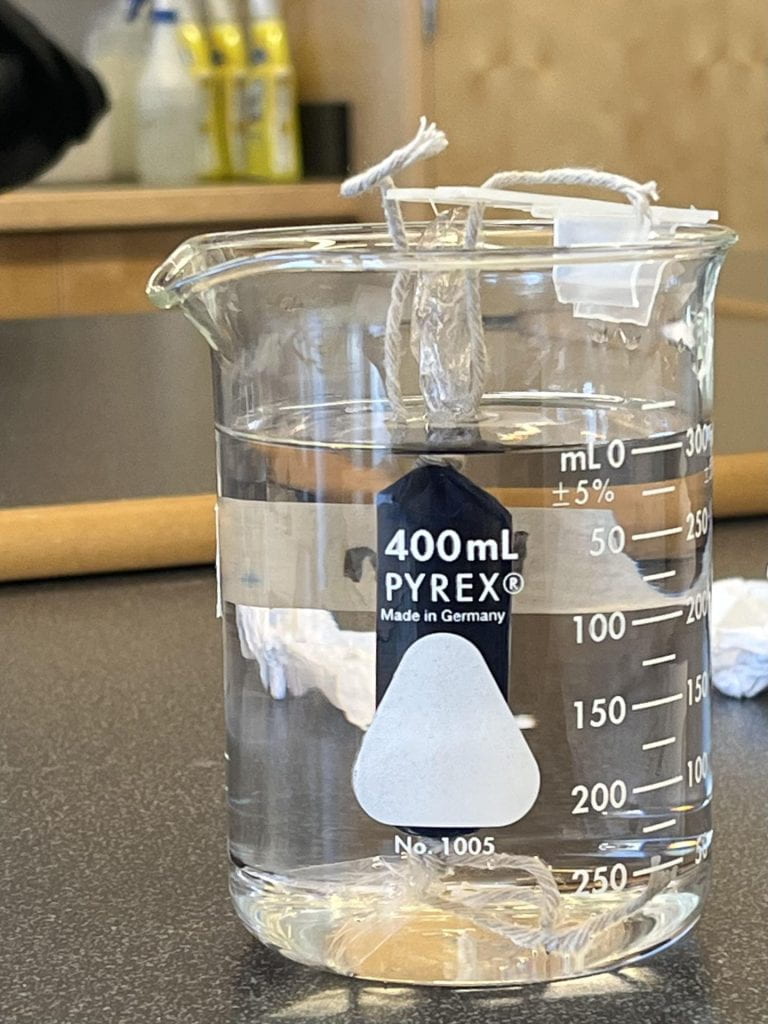

These are the photo from the cell membrane diffusion lab. The starch tubing is submerged in the IKI solution, and the initial yellow IKI solution turned colourless after 24 hours.
Thinking Core Competency
I demonstrated thinking core competency through my discussion questions. I analyzed the movement of molecules across the membrane based on the data recorded during the lab. I used evidence to make judgements or decisions as demonstrated in the drawing showing how molecules move in and out the cell. I used arrows to show if the molecule goes in or out of the membrane. At first, I thought water went in and out because the water volume stayed the same. However, look at my data, I realized that water only went into the membrane (not out) because the mass of the starch cell increased after 24 hours. An increase in the mass of the cell was due to osmosis. Although iodine also diffused into the membrane, there was a relatively small change in mass compared to water. I also analyzed the size of each molecule and the pore size based on my analysis. Since starch was the only molecule that didn’t go through the membrane, the starch would be the largest molecule. The iodine would be the smallest because it diffused into the molecule, and it’s an element. The pore size would be smaller than the molecules that went in and bigger than the ones that stayed out. I can describe how osmosis and diffusion related to this experiment of figuring out which molecules go in or out. I remained open minded as I explored viable options or alternative approaches, like when I tried to figure out what happened to the water molecules. Furthermore, I complied and synthesized information to draw reasoned conclusions, such as using my data and analysis to write a conclusion, which demonstrates my critical thinking skill to make judgement based on evidence.
Communication Core Competency
Throughout the diffusion lab, I demonstrated communication core competency by actively working with my partner to create a cell that diffuses well. Furthermore, I engaged in effective communication with the two other members in our group, who were using glucose while our group used starch in cell creation. We discussed the overall process and analyzed differences between the two cells, which showcases our collaborative effort to understand and compare results. In the discussion, I helped to build and extend understanding by asking and responding to questions, which allowed us to clarify concepts. We explained how we put the yellow IKI in the water, and other members explained how they waited 20 minutes and recorded the concentration of glucose outside the cell. Since we were doing the separate experiments, talking and sharing information became really crucial in terms of analyzing data and answering discussion questions of the lab. Examples of where I communicated clearly and purposefully can be seen in the two other members’ understanding of the starch experiment. Because we needed to understand both experiments to analyze, the two other members’ understanding of the overall process of the starch cell experiment indicated my clear communication with the group members. As an active listener, I noticed that I always tried to make connections with the course content, as well as between the two different data we got from starch and glucose. I realized that water iodine, and glucose were going into the cell, but starch wasn’t. However, we were all curious about why the water volume stayed the same. We kept discussing to figure out what happened to the water molecules, which indicates active and collaborative communication to deepen my understanding.
